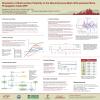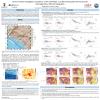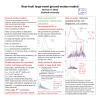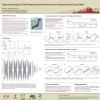Poster #218, Ground Motions
Refinements of UCSB Method Using a Double-Corner Frequency Source Spectrum
Poster Image:

Poster Presentation
2020 SCEC Annual Meeting, Poster #218, SCEC Contribution #10645 VIEW PDF
A realistic spectral model of the general f^(-2) high-frequency and M_0 low-frequency asymptotes needs an intermediate f^(-1) branch (Brune, 1970). We introduced two such double-corner source spectral models JA19 and JA19_2S for 3.3≤ M ≤7.3, constrained by stochastic modeling the mean PGA and mean PGV of the NGA West-2 database. JA19 is self-similar. Its two corner frequencies f_c1 and f_c2 scale with moment magnitude (M) as (1) 〖log(f〗_c1 (M))=1.754-0.5M and (2) 〖log(f〗_c2 (M))=3.250-0.5M. We find that relation (1) is consistent with the known self-similar scaling relations of the rupture duration (T_d), where T_d=1⁄((πf_c1)). Relation (2) may reflect scaling relation of the average rise time (T_R), where T_R~0.8⁄((f_c2)). Stochastic simulations using JA19 cannot reproduce the sharp change in magnitude dependence of PGA and PGV at M 5.3, suggesting a breakdown of self-similarity. To model this change, JA19_2S is found by perturbing the f_c1 scaling relationship in JA19. For JA19_2S: log(f_c1 (M))=1.474-0.415 M for M≤5.3; log(f_c1 (M))=2.375-0.585 M for M>5.3. In both models f_c2⁄f_c1 ≫1. Seismic radiated energy scales with 〖M_0〗^2 〖f_c1〗^2 f_c2. The ratio f_c2⁄f_c1 scales not only with the ratio of effective stress drop and static stress drop but also with the fault aspect ratio. To explore deviations in frequencies f_c1 and f_c2 for individual earthquakes, we use the double-corner spectrum to constrain the source realizations produced by UCSB Broadband kinematic method (Liu et al., 2006; Schmedes et al., 2013; Crempien and Archuleta, 2016). We demonstrate the fidelity of the technique by modeling the strong-motion recordings from three large earthquakes of the 2019 Ridgecrest sequence.


















































